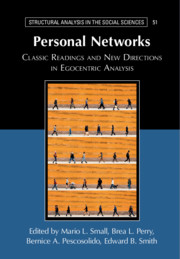Book contents
- Personal Networks
- Structural Analysis in the Social Sciences
- Personal Networks
- Copyright page
- Contents
- Figures
- Tables
- Contributors
- I Background
- II Early Foundations
- III Later Foundations
- IV New Perspectives
- 20 On Cognition
- 21 On Mobilization
- 22 On Trust
- 23 On Dynamics
- 24 On Inequality
- 25 On Culture
- 26 On Migration
- 27 On Movements
- 28 On Social Media
- Index
- Recent Books in the Series
- References
25 - On Culture
The Problem of Culture Flows in Weak Ties
from IV - New Perspectives
Published online by Cambridge University Press: 01 October 2021
- Personal Networks
- Structural Analysis in the Social Sciences
- Personal Networks
- Copyright page
- Contents
- Figures
- Tables
- Contributors
- I Background
- II Early Foundations
- III Later Foundations
- IV New Perspectives
- 20 On Cognition
- 21 On Mobilization
- 22 On Trust
- 23 On Dynamics
- 24 On Inequality
- 25 On Culture
- 26 On Migration
- 27 On Movements
- 28 On Social Media
- Index
- Recent Books in the Series
- References
Summary
Some kinds of useful culture flow well through weak ties, bringing more useful culture to people with a more diverse set of weak ties to acquaintances with a diverse cultural repertoire, as in Granovetter’s “Strength of Weak Ties.” But some kinds of culture do not flow well through most kinds of weak ties. To begin an understanding of such variations, I argue we should consider ties within and between unequal status groups in some form of inequality, since inequality powerfully shapes the kind of culture that people will be willing to send and receive in weak ties. I use my recent study of weak ties within and between the three most important ethnic groups in Toronto (White, Chinese, and Black) to explore when which kinds of culture flow, and to develop a theory of such flows using Weber on status groups, Simmel on sociability, a pinch of Bourdieu, and insights from leading qualitative work on interethnic relationships and culture.
Keywords
- Type
- Chapter
- Information
- Personal NetworksClassic Readings and New Directions in Egocentric Analysis, pp. 651 - 674Publisher: Cambridge University PressPrint publication year: 2021

